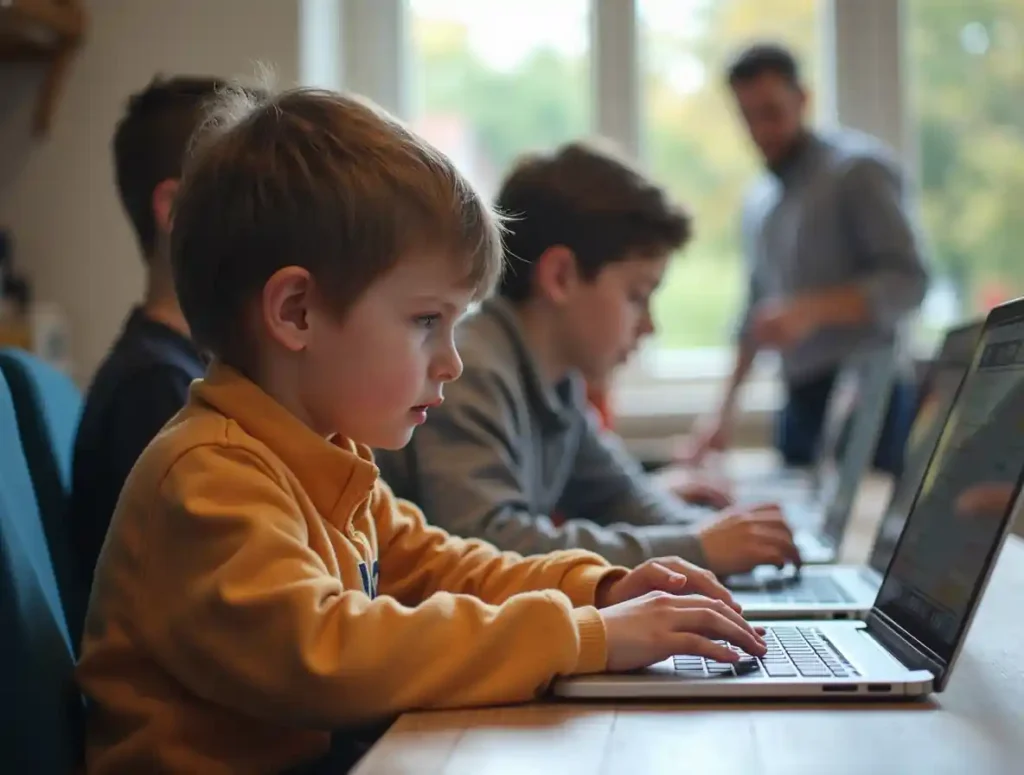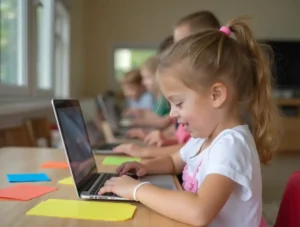In today’s tech-driven world, introducing kids to programming at an early age can spark creativity, enhance problem-solving skills, and open doors to future opportunities. In this blog post, we’ll explore the top programming tools for kids, highlighting their features, benefits
Best Coding Tools for Kids
In today’s technology-driven world, introducing children to coding at a young age can spark creativity. Coding strengthens problem-solving skills and opens doors to future opportunities. With a wide range of programming tools designed specifically for young learners, teaching kids to code has never been more accessible and engaging. These tools combine fun and interactive environments with educational content, making coding feel more like a game than a difficult task. In this article, we’ll explore the best coding tools for kids, highlighting their features, benefits, and reasons why they’re well-suited for young programmers.
Why Teach Kids to Code?
Before diving into the tools, let’s consider why coding is valuable for children. Learning to code helps kids develop critical thinking, logic, and creativity. This skill teaches them how to break down complex problems into manageable parts and fosters resilience through trial and error. Moreover, coding is a gateway to understanding technology—a skill increasingly essential in almost every industry. With child-friendly tools, parents and educators can make the learning process both enjoyable and rewarding.
In the following sections, we’ll look at some of the best coding tools for kids, categorized by age group and experience level, to help you choose the right one for your child or student.
Coding Tools for Young Beginners (Ages 5–8)
For younger children, visual, block-based programming tools are ideal. These platforms use drag-and-drop interfaces, colorful designs, and game-like experiences to introduce coding concepts without the need for typing or complex syntax.
1. ScratchJr
-
Best for: Ages 5–8
-
Platforms: iOS, Android, Web
-
Cost: Free
ScratchJr, developed by MIT, is a fantastic starting point for young children. It introduces basic programming concepts through a simple drag-and-drop interface. Kids can create their own stories and games by arranging colorful coding blocks. Each block represents a command, such as moving a character or playing a sound, making it easy for kids to understand cause-and-effect relationships in coding.
Why Kids Love It:
-
Bright and engaging visuals that feel like playing with digital toys.
-
Ability to customize characters and backgrounds, encouraging creativity.
-
Projects can be shared with family or friends, boosting confidence.
Educational Benefits:
-
Teaches sequencing, loops, and basic logic.
-
Encourages storytelling and creative expression.
-
No reading skills required, making it accessible for preschoolers.
Getting Started: Download the app on a tablet or use it via a web browser. Parents can guide kids through tutorials, but the visual interface allows independent exploration.
2. Code.org’s CodeSpark Academy
-
Best for: Ages 5–9
-
Platforms: iOS, Android, Web
-
Cost: Free with optional subscription for extra content
CodeSpark Academy is a game-like platform that uses puzzles and characters called The Foos to teach coding fundamentals. Kids solve challenges by arranging blocks of code to guide characters, collect rewards, and complete missions. Designed to feel like a game, it keeps kids engaged in learning.
Why Kids Love It:
-
Fun animated characters and lively graphics.
-
Game-like challenges with rewarding outcomes.
-
A “create” mode where kids can design their own games.
Educational Benefits:
-
Introduces loops, conditionals, and problem-solving.
-
Builds persistence through progressively harder puzzles.
-
Supports multiple languages, making it globally accessible.
Getting Started: Sign up for a free account on Code.org or download the app. The free version includes plenty of content, while subscriptions unlock advanced levels and features.
Coding Tools for Intermediate Learners (Ages 8–16)
As kids grow more comfortable with coding concepts, they can transition to tools that introduce more advanced ideas while maintaining fun and supportive environments.
3. Scratch
-
Best for: Ages 8–16
-
Platforms: Web, Desktop
-
Cost: Free
Scratch, also developed by MIT, is the “big sibling” of ScratchJr and one of the most popular coding platforms for kids. It uses a block-based interface to create animations, games, and interactive stories. With a vibrant online community, kids can share their projects, remix others’ work, and learn from peers around the world.
Why Kids Love It:
-
Endless creative possibilities, from simple animations to complex games.
-
Supportive community where kids can explore and learn from others.
-
Tutorials and examples make getting started easy.
Educational Benefits:
-
Introduces variables, conditionals, and event-driven programming.
-
Promotes collaboration and creativity through project sharing.
-
Builds confidence as kids see their ideas come to life.
Getting Started: Visit the Scratch website to start coding directly in the browser—no installation needed. The platform includes beginner-friendly tutorials.
4. Tynker
-
Best for: Ages 7–14
-
Platforms: Web, iOS, Android
-
Cost: Free with premium subscriptions
Tynker is a versatile platform that offers block-based coding for beginners and gradually transitions to text-based languages like Python and JavaScript for older learners. It includes a wide variety of courses, from game design to robotics, and supports popular platforms like Minecraft and LEGO Mindstorms.
Why Kids Love It:
-
Exciting themes like Minecraft modding and drone programming.
-
Interactive lessons that feel like games.
-
Smooth transition from blocks to text-based coding.
Educational Benefits:
-
Covers a wide range of programming concepts, from loops to functions.
-
Introduces real-world applications like robotics and game development.
-
Encourages problem-solving through hands-on projects.
Getting Started: Create a free account on Tynker’s website or app. Free courses are available, while premium plans unlock more advanced lessons and tools.
Coding Tools for Advanced Young Programmers (Ages 12+)
For teens or kids with prior experience, tools introducing text-based coding and more complex projects can help them take their skills to the next level.
5. CodeMonkey
-
Best for: Ages 9–14
-
Platforms: Web
-
Cost: Subscription-based with free trial courses
CodeMonkey teaches kids to write in real programming languages like CoffeeScript and Python through game-like challenges. Kids guide a monkey through levels, collecting bananas and overcoming obstacles by writing code. It balances fun with the rigor of text-based programming.
Why Kids Love It:
-
Engaging storyline and characters make coding feel like an adventure.
-
Instant feedback on code correctness.
-
Progression from simple to challenging tasks.
Educational Benefits:
-
Introduces text-based programming in a beginner-friendly way.
-
Teaches debugging and problem-solving skills.
-
Prepares kids for advanced coding languages.
Getting Started: Sign up for a free trial on the CodeMonkey website. Subscriptions provide access to full courses and additional features.
6. Blockly
-
Best for: Ages 10+
-
Platforms: Web, Desktop
-
Cost: Free
Blockly, developed by Google, is a flexible block-based tool that can be used to learn languages like Python, Lua, and JavaScript. Highly customizable, it allows educators and parents to design tailored coding experiences. Blockly is used in many educational platforms, including Code.org, and supports a wide range of programming environments.
Why Kids Love It:
-
Adaptable to multiple programming languages.
-
Interactive, visual interface for learning text-based coding.
-
Open-source and widely supported by educational communities.
Educational Benefits:
-
Bridges block-based and text-based programming.
-
Teaches syntax and structure of real programming languages.
-
Encourages experimentation with customizable blocks.
Getting Started: Access Blockly through its website or integrated platforms like Code.org. Free and open-source, it also comes with extensive online tutorials.
Additional Tools for Creative Coding
7. Bitsbox
-
Best for: Ages 6–12
-
Platforms: Web
-
Cost: Free with premium subscriptions
Bitsbox teaches kids to build simple apps using JavaScript through a child-friendly interface. Each project starts with a digital “card” containing snippets of code that kids can modify and experiment with, creating apps that run on any device.
Why Kids Love It:
-
Create real, shareable apps that work on smartphones and tablets.
-
Fun, colorful designs and ready-made templates.
-
Encourages creativity with endless app-making possibilities.
Educational Benefits:
-
Introduces JavaScript in an accessible way.
-
Teaches app development and user interface design.
-
Builds confidence through practical, shareable projects.
Getting Started: Visit the Bitsbox website to start with free projects. Premium subscriptions offer more templates and advanced features.
8. MakeCode
-
Best for: Ages 8+
-
Platforms: Web
-
Cost: Free
Microsoft MakeCode is a free platform that supports both block-based and text-based coding for creating games, animations, and hardware projects. Compatible with microcontrollers like micro:bit, it offers simulators so kids can test their code directly in the browser.
Why Kids Love It:
-
Supports block coding and JavaScript.
-
Interactive simulators provide instant results.
-
Hardware integration for real-world projects like robotics.
Educational Benefits:
-
Teaches coding skills across software and hardware.
-
Encourages experimentation through simulations.
-
Supports advanced concepts like variables and functions.
Getting Started: Access MakeCode via its website—no account needed. Tutorials guide kids through the learning process.
Tips for Parents and Educators
-
Start Simple: Choose a tool that matches your child’s age and skill level. Young kids thrive with ScratchJr or CodeSpark, while older ones can try Scratch or Tynker.
-
Encourage Exploration: Let kids experiment and make mistakes—it’s part of the learning process.
-
Get Involved: Coding can be a fun family or classroom activity. Code together to build collaboration and excitement.
-
Set Goals: Encourage kids to create a small project, like a game or animation, to stay motivated.
-
Celebrate Success: Share their projects with family or online communities to build confidence.
Conclusion
Coding is a valuable skill that empowers kids to create, innovate, and understand the digital world. With tools like ScratchJr, CodeSpark, Scratch, Tynker, CodeMonkey, Blockly, Bitsbox, and MakeCode, children can learn coding in fun, engaging ways tailored to their age and interests. These platforms make coding accessible, foster creativity and problem-solving, and prepare kids for a future shaped by technology.
Start with one of these tools today and watch your child’s imagination soar as they build games, apps, and stories of their own. The world of coding is at their fingertips—let’s inspire the next generation of creators!




